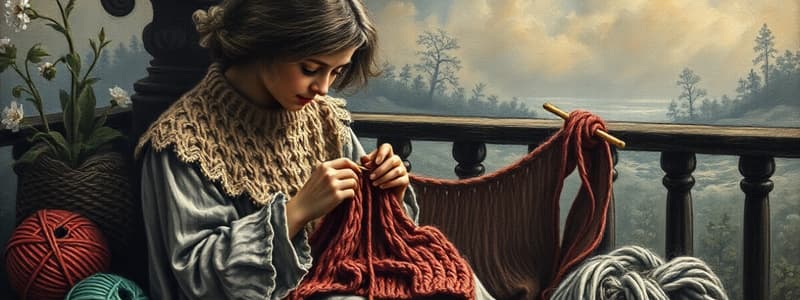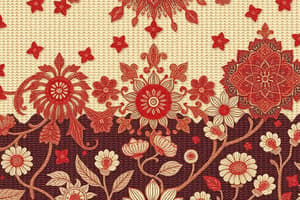Podcast
Questions and Answers
Explain one key difference between hand knitting and machine knitting, focusing on the process and typical scale of production.
Explain one key difference between hand knitting and machine knitting, focusing on the process and typical scale of production.
Hand knitting is done manually using needles to interlock loops one at a time, typically for smaller, artisanal projects. Machine knitting uses automated processes to create rows of loops more rapidly, enabling larger-scale fabric or garment production.
Describe the garter stitch and explain how it is created using the basic knit and purl stitches.
Describe the garter stitch and explain how it is created using the basic knit and purl stitches.
Garter stitch is a fabric with horizontal ridges on both sides, created by knitting every row. This means on both the 'right side' and 'wrong side' of the fabric, you perform only the knit stitch, resulting in a reversible, textured fabric.
How does the size of knitting needles affect the gauge of a knitted fabric, and why is gauge important in knitting projects?
How does the size of knitting needles affect the gauge of a knitted fabric, and why is gauge important in knitting projects?
Larger needles create larger loops, resulting in a looser gauge (fewer stitches and rows per inch). Gauge is crucial because patterns are written to a specific gauge; using a different gauge will alter the final size of the knitted item, potentially leading to fit issues.
Explain how yarn weight influences the drape of a knitted fabric. Provide an example of a yarn weight suitable for a project requiring good drape.
Explain how yarn weight influences the drape of a knitted fabric. Provide an example of a yarn weight suitable for a project requiring good drape.
What is the purpose of 'binding off' in knitting, and why is it a necessary step to complete a knitted project?
What is the purpose of 'binding off' in knitting, and why is it a necessary step to complete a knitted project?
Describe three essential pieces of information typically found in a knitting pattern, besides the row-by-row instructions.
Describe three essential pieces of information typically found in a knitting pattern, besides the row-by-row instructions.
How did the invention of the knitting machine impact the textile industry and the role of hand knitting?
How did the invention of the knitting machine impact the textile industry and the role of hand knitting?
Explain how to create stockinette stitch when knitting in the round using circular needles. Specify which stitch (knit or purl) is used for each round.
Explain how to create stockinette stitch when knitting in the round using circular needles. Specify which stitch (knit or purl) is used for each round.
If you want to knit a cable design, what type of yarn fiber would be most suitable and why?
If you want to knit a cable design, what type of yarn fiber would be most suitable and why?
Describe one common modification a knitter might make to a pattern to customize the fit of a garment, and explain how this modification is achieved technically in knitting.
Describe one common modification a knitter might make to a pattern to customize the fit of a garment, and explain how this modification is achieved technically in knitting.
Flashcards
What is Knitting?
What is Knitting?
Creating fabric by interlocking loops of yarn using needles or a machine.
What is hand knitting?
What is hand knitting?
Using two needles to interlock loops of yarn by hand.
Knit and purl stitches
Knit and purl stitches
The two basic stitches in knitting.
What is a knit stitch?
What is a knit stitch?
Signup and view all the flashcards
What are circular needles?
What are circular needles?
Signup and view all the flashcards
What is yarn?
What is yarn?
Signup and view all the flashcards
What is casting on?
What is casting on?
Signup and view all the flashcards
What is binding off?
What is binding off?
Signup and view all the flashcards
What is increasing?
What is increasing?
Signup and view all the flashcards
What is decreasing?
What is decreasing?
Signup and view all the flashcards
Study Notes
- Knitting is a method of creating fabric by interlocking loops of yarn using knitting needles or a machine.
Basics of Knitting
- Knitting can be done by hand or by machine.
- Hand knitting involves using two needles to interlock loops of yarn, while machine knitting uses a machine to create rows of interlocked loops.
- The two basic stitches in knitting are the knit stitch and the purl stitch.
- Combining these stitches allows for a wide variety of patterns.
- Knit fabrics are known for their elasticity, which makes them comfortable to wear.
- Basic equipment includes yarn, knitting needles, and scissors.
- Additional tools may include stitch markers, row counters, and cable needles.
Knit Stitch and Purl Stitch
- The knit stitch involves inserting the right needle into the front of a loop on the left needle, wrapping the yarn around the right needle, and pulling it through to create a new loop.
- The purl stitch involves inserting the right needle into the front of a loop on the left needle, wrapping the yarn around the right needle, and pulling it through to create a new loop.
- In the purl stitch, the yarn is held in front of the work.
- The knit stitch creates a V-shaped pattern on the front of the fabric, while the purl stitch creates a horizontal bump.
- Alternating rows of knit and purl stitches creates a fabric known as garter stitch.
- Stockinette stitch is created by knitting all stitches on one side and purling all stitches on the other side.
Knitting Needles
- Knitting needles come in various sizes, typically measured in millimeters or US sizes.
- The size of the needle affects the gauge (number of stitches and rows per inch) of the knitted fabric.
- Common types of knitting needles include straight needles, circular needles, and double-pointed needles.
- Straight needles are used for knitting flat pieces, while circular needles can be used for both flat and circular knitting.
- Double-pointed needles are typically used for knitting in the round, such as socks or hats.
- Needle material can be metal, plastic, bamboo, or wood.
Yarn
- Yarn is the basic material used in knitting, and it comes in a variety of fibers, weights, and colors.
- Common yarn fibers include wool, cotton, acrylic, and blends.
- Yarn weight refers to the thickness of the yarn, which affects the gauge and drape of the knitted fabric.
- Common yarn weights include lace, fingering, sport, DK, worsted, and bulky.
- The choice of yarn depends on the project and desired properties of the finished fabric.
Knitting Techniques
- Casting on is the method of creating the initial row of stitches on the needle.
- Binding off is the method of securing the stitches at the end of a project to prevent unraveling.
- Increasing involves adding stitches to a row to widen the fabric.
- Decreasing involves reducing stitches in a row to narrow the fabric.
- Cables are created by crossing stitches over each other to create a textured design.
- Intarsia and Fair Isle are colorwork techniques that involve using multiple colors of yarn to create patterns.
Knitting Patterns
- Knitting patterns provide instructions for creating specific items, such as sweaters, scarves, or hats.
- Patterns typically include a list of materials, gauge information, stitch abbreviations, and row-by-row instructions.
- Patterns may also include charts or diagrams to illustrate stitch patterns or construction techniques.
- Knitting patterns can range from simple designs for beginners to complex projects for experienced knitters.
- Modifying patterns is a common practice to customize the design or fit of a knitted item.
History of Knitting
- Knitting originated in the Middle East, with the earliest known examples dating back to the 11th century AD.
- It spread to Europe through trade routes, becoming a popular craft in Spain and other Mediterranean countries.
- Knitting guilds were established in Europe during the Middle Ages, regulating the production and sale of knitted goods.
- The invention of the knitting machine in the 16th century revolutionized the textile industry, allowing for faster and more efficient production of knitted fabrics.
- Hand knitting remained popular, particularly for creating handmade garments and decorative items.
- Knitting has undergone revivals at different periods, including during wartime as a way to create garments for soldiers, and as a popular hobby.
Studying That Suits You
Use AI to generate personalized quizzes and flashcards to suit your learning preferences.
Description
Learn the basics of knitting, including hand and machine methods. Discover the knit and purl stitches, and the elasticity of knit fabrics. Essential equipment includes yarn, needles, and handy tools.




